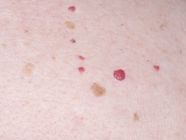Diaper rash is one of the most common skin conditions in infants, affecting more than 50% of babies at some point in their development. The main cause is prolonged exposure to a wet or dirty diaper, as the moisture and ammonia from urine or stool can irritate the baby’s delicate skin. That’s why keeping the area clean and dry is the single most important step in treating diaper rash. (1)
How to Treat Diaper Rash in Babies
Home Care Tips
Here are the most important pediatric dermatologist-approved tips to help treat diaper rash: (2)(3)
- Change the diaper as soon as it’s wet or soiled:
This is the key step in both treatment and prevention. Check the diaper every 1–2 hours and change it immediately—even if it’s only slightly soiled. Less moisture = faster healing.
- Gently clean and dry the diaper area:
Clean the skin gently using warm water and a soft cloth—no scrubbing. After washing, pat the area dry using a soft towel or tissue designated for drying. Avoid rubbing the skin.
The rash area can also be gently disinfected with a diluted antiseptic solution, such as Potassium Permanganate, under a doctor’s guidance.
- Apply a diaper rash cream:
Use a zinc oxide-based barrier cream to protect the skin from moisture. After cleaning and drying, apply a thick layer of the cream after each diaper change. You don’t need to wipe off the previous layer unless it’s soiled—just add more on top. The thicker, the better!
- Use a medicated cream with corticosteroid and antifungal:
If the rash is more severe or persistent, your doctor may recommend a combination cream that contains a mild steroid (0.5–1% hydrocortisone) with an antifungal agent. These are available in single tubes, such as Daktacort cream, and are usually applied twice a day for 3–5 days.
- Let the skin breathe:
- Air exposure is important to help the skin heal. Try:
- Letting your baby go diaper-free for short periods (e.g., nap time).
- Loosening the diaper tabs slightly.
- Using a diaper one size larger until the rash heals.
- Daily bath time:
Bathe your baby daily during the rash using warm water and a mild, fragrance-free cleanser.
When to See a Doctor
Contact your pediatrician or dermatologist if your baby: (4)
- Doesn’t improve within 2–3 days of home care.
- Has blisters, pimples, or bleeding in the diaper area.
- Develops a rash that spreads beyond the diaper region.
- Has a fever or is in severe pain with the rash.
At Al-Ahli Hospital, our pediatric team provides comprehensive, specialized care to help your baby heal from diaper rash quickly and comfortably. Book your appointment today.
Frequently Asked Questions
Is breast milk effective for diaper rash?
Some studies show that breast milk may be as effective as 1% hydrocortisone cream in treating diaper rash. However, research results are mixed. It’s generally safe and worth trying as a natural remedy. (5)
Is baby powder safe for diaper rash?
No. Baby powder is not recommended due to the risk of inhalation and potential respiratory issues. It’s best to stick with pediatrician-approved creams and ointments. (4)
Which diaper brand is best for diaper rash?
There’s no single “best” diaper brand, but highly absorbent diapers are preferable, as they keep your baby’s skin dry for longer. If you use cloth diapers, consider switching to disposable ones temporarily during flare-ups. (1)
References
- HealthyChildren - Common Diaper Rashes & Treatments
- American Academy of Dermatology Association - How to treat diaper rash
- Mayo Clinic - Diaper rash
- Cleveland Clinic - Diaper Rash (Diaper Dermatitis)
- NIH NLM - Milk Therapy: Unexpected Uses for Human Breast Milk






